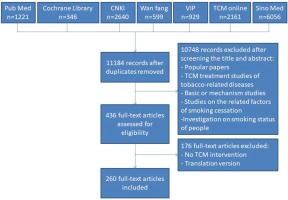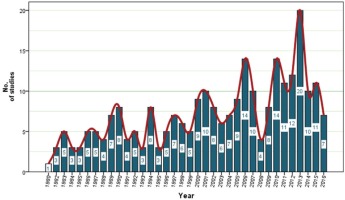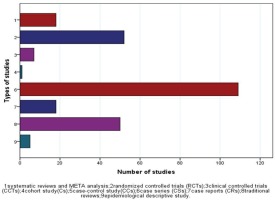INTRODUCTION
Smoke from cigarettes contains a variety of harmful substances1-3 and smoking is one of the principal causes of chronic obstructive pulmonary disease, cancer, atherosclerotic cardiovascular disease and cerebrovascular disease4,5, which are the most common causes of morbidity and mortality6-8. The World Health Organization (WHO) reports that tobacco-use causes the death of about 6 million people worldwide every year9. More than 5 million of these deaths are associated directly with the use of tobacco, with more than 600 000 of these deaths corresponding to non-smokers exposed to secondhand smoke9. Smoking addiction is a complex problem, involving physical, psychological, social and other factors10, mainly due to nicotine, the psychoactive substance contained in cigarettes11,12. The development of smoking-related diseases and the associated risk of death significantly decrease in smokers who quit smoking13,14. Under the guidance of WHO, countries worldwide are taking active measures against smoking15,16.
The most common recommended approaches to quitting smoking include nicotine replacement therapy, antidepressants and psychological support17-29. Despite the high cost, the effectiveness of these approaches is limited and side effects (such as anorexia, nausea, constipation, headache, drowsiness or insomnia) can occur30,31. Therefore, new approaches that could help smokers to quit smoking are warranted. Traditional Chinese Medicine (TCM) therapy is widely used to aid smoking cessation, and because of its relative safety, low cost and claimed effectiveness, it has attracted increasing attention worldwide32,33. The application of TCM therapy to smoking cessation has a long history in China. Its aim is to inhibit the craving for cigarettes and to alleviate withdrawal symptoms34. There is widespread interest in TCM therapy for smoking cessation, especially the use of acupuncture which has been investigated in a series of clinical studies. Despite this, the effectiveness of TCM therapy for smoking cessation is still controversial.
We are, therefore, committed to obtaining insights on the role of TCM therapy in the field of smoking cessation. This comprehensive bibliometric analysis aims to provide an overview of the status of TCM therapy as an intervention for smoking cessation worldwide. We intend to identify, develop and offer appropriate evidence-based TCM approaches to help people to quit smoking, as well as to provide a framework for further evaluating the efficacy of the most promising TCM approaches for smoking cessation.
METHODS
Search strategy
We searched five Chinese and two English language electronic databases (see Additional file 1 for details). With two library staff members (SCL and JFL), we developed the search terms and conducted literature searches. In order not to miss relevant articles, we decided not to set other limitations on the searching.
Eligibility criteria
We included all types of clinical studies: randomized controlled trials (RCTs), clinical controlled trials (CCTs), cohort studies, case-control studies, case series and case reports. Descriptive epidemiological studies (cross-sectional surveys), systematic reviews and traditional reviews on TCM therapies for smoking cessation were also included. Editorials and letters to the editor were excluded. When the same data were published more than once, we chose those that provided more comprehensive information. We considered documents to be eligible those which aimed at evaluating the therapeutic effect or safety of smoking cessation by TCM therapies. Those studies that were conducted to study mechanisms of action were not included.
Types of interventions
For clinical studies, we placed no limitations on the types of TCM therapies, such as acupuncture, acupressure, massage, herbal formulae, herbal extracts, plaster on acupuncture points, qi gong, Tai chi, and so on. In fact, we intended to understand the overall view of the therapeutic effect of all types of TCM therapies in the field of smoking cessation. Monotherapy (acupuncture, qi gong, etc.) and multiple therapies that combined TCM therapy with other interventions (acupuncture plus auricular acupressure, acupuncture plus nicotine replacement therapy, etc.) were all included.
Comparisons
For controlled clinical studies, including RCTs, CCTs, cohort studies and case-control studies, the control interventions were: no treatment, sham treatment, waiting list, other treatment, and combined therapy. The control intervention of some studies was a no-treatment control35 or waiting list36. Some studies utilized sham acupuncture or placebo as the control intervention37,38. Single and combined therapies, such as nicotine replacement therapy39, behavioral therapy36, TCM therapy plus counseling40, and so on, are also often applied as control interventions.
Data extraction and analysis
One author (XFD) imported the retrieved bibliography citations into NoteExpress (3.2.0.6976), and duplicates were deleted. JHW first screened the articles that clearly did not meet the inclusion criteria based on the reading of titles and abstracts. Next, two review authors (JHW and MH) selected eligible articles by reading the full text independently. JPL was responsible for resolving differences and contradictions in the screening process of the two authors, and for checking the eligibility of included articles. Three review authors (JHW, WQ, BC) extracted data from the included studies with a self-developed electronic data extraction form using the public domain software package Epidata (version 3.1). In case of disagreement, a consensus was reached by discussion with JPL. The extracted variables included: publication characteristics, study design, demographic characteristics, intervention details, control treatment details, and clinical outcomes.
The extracted data were imported into SPSS (release 20.0, IBM, Armonk, NY, USA) and Microsoft Excel (version 12.3.5, Microsoft, Redmond, WA, USA), which were used for the statistical analysis and to describe the characteristics of the data. Categorical variables were represented by frequencies and percentages, while continuous variables were reported as means and standard deviations.
RESULTS
General description of included literature
A total of 260 records were included and analyzed in this study (Figure 1), of these 178 (68.5%) articles were published in Chinese, while 82 (31.5%) articles were in English. Journal articles (244, 93.8%) were the most frequent publication type, followed by dissertations (8, 3.1%), and conference full text papers (6, 2.3%). Most of the studies were conducted by universities or medical colleges (106, 40.8%). Hospitals (96, 36.9%) also played an important role in studies related to smoking cessation using TCM therapy, followed by research institutes (30, 11.5%) and associations (4, 1.9%). Other clinical settings (16, 6.2%) in which smoking cessation studies were carried out included: clinics, community health centers, nursing homes, companies, and foreign aid medical teams. Seven (2.7%) articles provided no information about the institution. Among the 260 articles, 205 (78.8%) studies did not report whether they had been funded, 52 (20%) studies received financial support, and 3 (1.2%) did not have any financial aid.
Annual publications on smoking cessation using TCM therapy are summarized in Figure 2. The earliest publication year was 1980, at that time there was just one article produced. The first study was a case series conducted by a Chinese doctor in West African Senegal. From 1980 to 2016, the annual number of publications related to smoking cessation using TCM therapy increased slightly, with a peak of 14 in 2006. In terms of the number of publications, there was a significant decline until 2008. Since 2009 and 2010, there has been a large increase in publications, peaking in 2013. From 2013 to 2016, the annual number of publications decreased significantly. The long-term trend is a gradual increase in the number of publications.
The top seven countries, in which studies were carried out, were mainland China (129, 49.6%), USA (27, 10.4%), UK (25, 9.6%), Republic of Korea (9, 3.5%), Taiwan, China (7, 2.7%), Australia (5, 1.9%), Malta (4, 1.5%), followed by 31 other countries.
Nearly half of the 260 articles were performed in mainland China, and another 40 studies performed in other countries were conducted by Chinese who were providing medical aid abroad, including twelve African countries, Austria, Germany, Republic of Korea, Kuwait, Lao People’s Democratic Republic, Portugal, Russian Federation, Singapore, Switzerland, Thailand, Turkey, UAE, UK and the USA. Only one study was a collaboration conducted in mainland China and Taiwan, China (Table 1).
Table 1
Distribution of countries where the studies of smoking cessation using TCM therapies were performed
Active authors in publishing articles about smoking cessation using TCM therapy are shown in Table 2, with White being the most prolific contributor with 10 articles. Ten active authors were Chinese, and the other active authors were from Republic of Korea, France, USA and Taiwan, China.
Table 2
First authors who produced two or more articles on smoking cessation using TCM therapies
Table 3 ranks the journals by the number of publications. Chinese Acupuncture & Moxibustion outranked other journals with 21 publications. Of the top 10 active journals, 7 were Chinese journals, and 3 were in English.
Table 3
Top ten most active journals in the field of smoking cessation applying TCM therapy
Study types
Figure 3 illustrates that the great majority of the literature consists of case series (110, 42.3%), followed by RCTs (52, 20.0%), traditional reviews (50, 19.2%), individual case reports (18, 6.9%), systematic reviews (17, 6.5%) and CCTs (7, 2.7%). Cross-sectional descriptive epidemiological studies (5, 1.9%) accounted for less of the data and cohort studies were the least common (1, 0.3%).
Case series was the earliest type of study41, which was reported in the Journal of Traditional Chinese Medicine, in Chinese, with smoking cessation rate reaching 90.95% after intervention by body acupuncture and auxiliary ear acupoint buried needle. Case series was also the most frequently applied study type for investigating the effectiveness of TCM for smoking cessation, and it was particularly popular in China. Of the case series, 103 were conducted by Chinese, while only 7 were conducted by other countries. Compared to RCTs, case series are easier to complete. The first RCTs42 about smoking cessation using TCM therapy were published in Am J Chin Med in 1982, conducted in the USA comparing the smoking cessation efficacy of real ear acupuncture (RA) and sham ear acupuncture. Most of the systematic reviews (16/17) were published in English journals. The British Journal of General Practice reported the first meta analysis of studies on the effect of acupuncture on addiction43.
Participants
There were 36 645 participants in the 188 clinical studies, excluding the 67 reviews and 5 descriptive epidemiological studies. The largest sample size was 8803 (a case series conducted in Guangxi China with a reported rate of smoking cessation of 95.0%, while the smallest study had an N=1 (case report). In all, 21 990 (60.0%) were male and 14 655 (40.0%) were female. Of the 188 clinical studies, only 11 studies reported a detailed ethnic distribution of participants. The analysis of extracted data indicated that the youngest participant was 12 years old and the oldest 86 years. The duration of regular active or passive smoking of all participants varied from 3 months to 70 years. There was a wide variation in the number of cigarettes consumed daily (3-100).
Therapy category
A total of 173 (92.0%) publications of 188 clinical studies did not report any information about diagnostic criteria of tobacco dependence. Only 22 (11.7%) studies reported the use of syndrome differentiation to guide treatment. Regarding the treatment principle of traditional Chinese medicine, 34 (18.1%) clinical studies described it in detail, including the treatment principle of Tiao Li Fei Qi, Shu Gan Jian Pi, Zhen Jing An Shen. Overall, 142 (75.5%) of the 188 studies clearly recorded the operational steps and specifications of the treatment approach. Details on the course of treatment could not be found in 9 (4.8%) articles, and another 11 (5.9%) articles lacked detail on the treatment sessions. In the remaining 168 studies, the average duration of treatment varied from 10 minutes to 12 weeks. Table 4 illustrates the varied nature of TCM interventions employed to aid smoking cessation.
Table 4
Number of different categories of therapies in clinical studies
Outcomes
Of the 188 clinical studies, 111 (59.0%) reported follow-up after the therapy ranging from 26 hours44 to 5 years45. Seventy (37.2%) clinical studies failed to report the main efficacy criteria. The TCM therapy effectiveness was reported comprehensively in 111 (59.0%) studies, smoking cessation rate was reported in 77 (41.0%), smoking craving in 24 (12.8%), nicotine dependence scale in 19 (10.1%), changes in withdrawal symptoms in 33 (17.6%), decrease in daily cigarette consumption in 47 (25.0%), change in the taste of cigarettes in 25 (13.3%), and laboratory parameters in 33 (17.6%). Five (2.7%) studies included assessment of quality of life. Forty-one (21.8%) studies focused on the safety of the therapy, including adverse events and/or adverse drug reactions. Two studies (1.1%) reported health economic data.
DISCUSSION
The present study identified and comprehensively analyzed 260 publications of TCM therapy for smoking cessation. Mainland China was the main country that investigated TCM for smoking cessation. On the other hand, our study also showed that TCM therapy is widely accepted and used in the field of smoking treatment throughout the world. However, international collaboration on this topic is rare. Systematic reviews are important in the field of efficacy evaluation. A systematic review of clinical trials46 published in 2014 concluded that there was not enough evidence indicating acupuncture was effective in smoking cessation. This finding is inconsistent with a large body of outcome data on clinical practice.
As a bibliometric study, we tried to identify all available clinical evidence on TCM therapies for smoking cessation. Therefore, all types of experimental and observational studies, review articles and descriptive epidemiological studies related to smoking cessation applying TCM therapy were retrieved. We found a predominance of case series. The number of RCTs, considered by many to be the gold standard for clinical efficacy, was less than half the number of case series. This may be one of the reasons why the efficacy of TCM therapy for smoking cessation is not widely recognized globally. Targeting the individual treatment characteristics and current status of clinical research in TCM, a proposal for evidence grading that focused not only on RCTs but also on cohort studies, case-control studies, case series was suggested47, in order to reflect the efficacy of TCM more objectively and correctly.
Due to the diversity and flexibility of TCM therapy, smoking cessation therapy was applied in different ways according to the actual situation of the smokers, the stage of the smoking cessation process48 and clinical experience of the researchers. This included single TCM therapies, as well as various treatment combinations, including those with western therapy such as nicotine replacement therapy. The application of TCM syndrome differentiation made the treatment more complicated. It is difficult to develop a unified, repeatable TCM therapy for smoking cessation. This undoubtedly hinders the spread of TCM therapy for smoking cessation and makes it difficult to carry out a systematic review on the beneficial effect of smoking cessation using TCM therapy. An additional table file shows this in more detail [see Additional file 2].
This bibliometric analysis has several limitations, including selection of databases and language restrictions. At present, there is a variety of databases, specialized or generalized. Due to resource constraints, we could not retrieve all the databases, especially some English databases, such as Google Scholar, and the acupuncture academic professional database, which may have led to missing publications. Moreover, limiting our analysis to articles published in Chinese and English, means that we missed publications in other languages, such as French, Korean, Japanese, German, Russian, etc.
CONCLUSIONS
To our knowledge, the available data related on TCM therapy for smoking cessation has been comprehensively described for the first time based on a systematic bibliometric approach. Our study revealed the characteristics of the literature on TCM therapy for smoking cessation. It included a general description of the available literature, study types, interventions, participants and outcome assessments. This provides a useful overview for researchers and clinicians with an interest in the topic of smoking cessation. The design types of research used in the area of smoking cessation using TCM may provide a reference for future research on evidence evaluation on this topic. The analysis of all kinds of interventions, especially acupuncture, may provide a reference for the selection of interventions for clinical practice or future research of addiction.
Whilst mainland China is the leading country to conduct research on TCM therapy, many other countries are also active in this field. Especially, acupuncture therapy has been applied to help smokers quit smoking worldwide. Despite the importance of smoking cessation using TCM therapy, the extent of international collaboration on this topic is very small. This paper may help to foster further cooperation.




